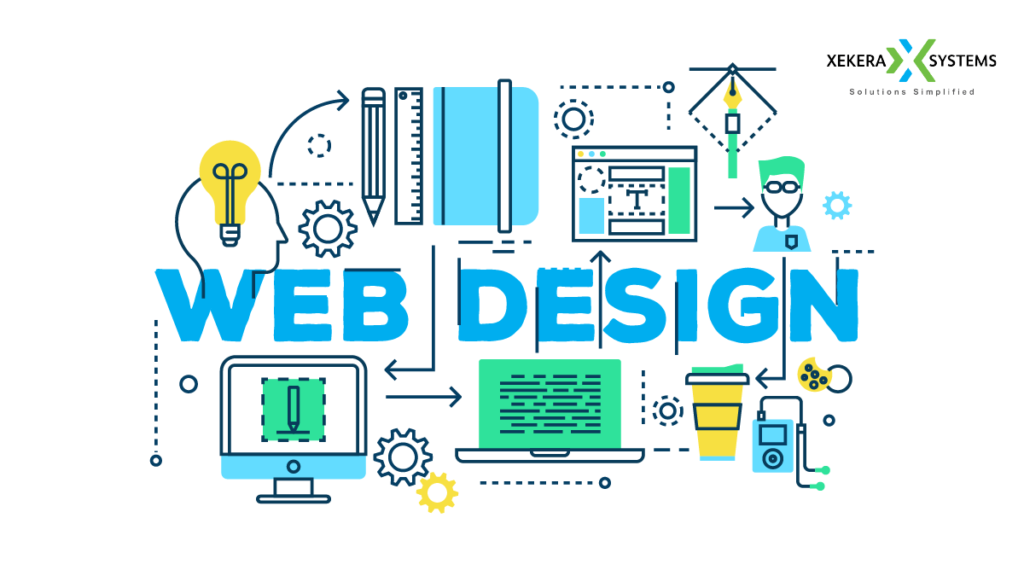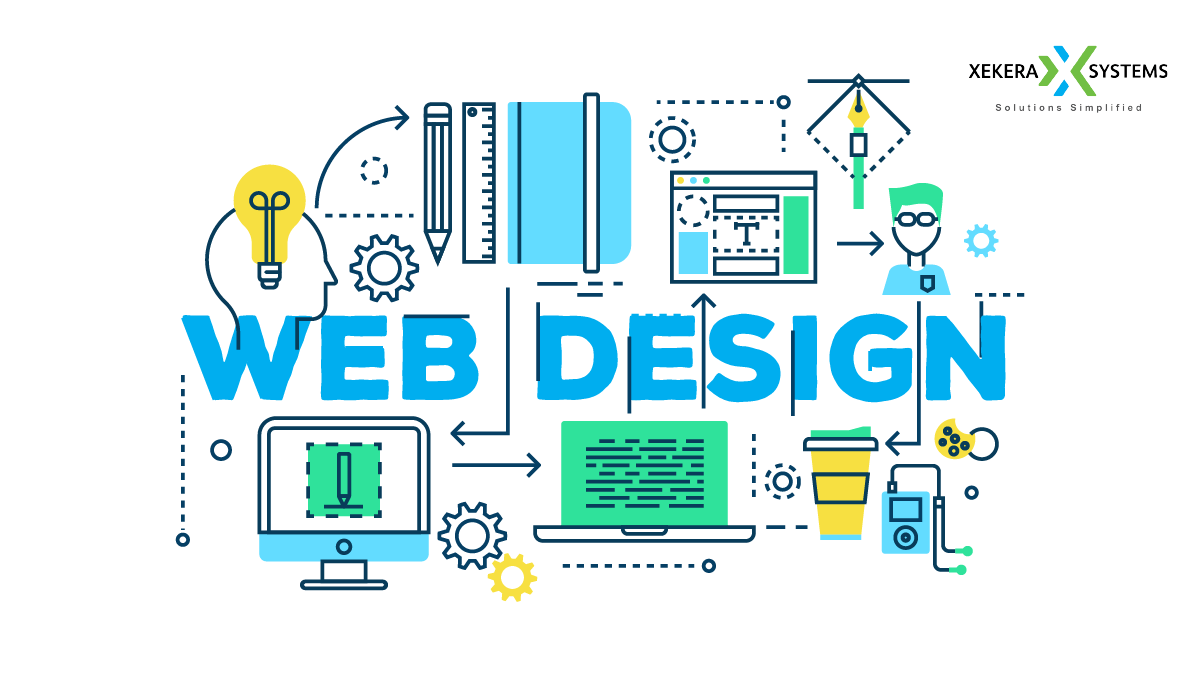Web design, also called website design, is the process of creating the visuals of a website, which includes color schemes, font selection, page layouts, and more. Keep reading to learn more about web design, including how it differs from web development!
Web design is vital to your online marketing
If you want your digital marketing to be successful, you need to drive traffic to your website – but that traffic will only stay there if your website is user-friendly. That’s why it’s important to have a quality web design.
When you visit a website, you expect it to look attractive and run smoothly. If you went to a website that took forever to load, had a garish color scheme, and hard-to-read text, you’d probably hit the “back” button.
Your potential customers would react in the same way, so your website must have a clean web design that draws users in rather than driving them away. But what exactly is web design and what does it take to improve it?
We answer these questions in our website design overview below, so read on to learn more. Then consider partnering with our team of marketing professionals for our web design services. Call (408) 982-5851or contact us online to get started!
What is web design?
To start our overview of web design, what is web design?
Web design refers to the process of creating a website, from the structure of each page to color schemes and font selection. Without web design, you won’t deliver a structured presentation of your site that invites users to engage.

What is the difference between web design and web development?
It is worth noting the difference between web design and web development. Web development is a broader term and includes setting up the back-end side of your website – that is, all the behind-the-scenes coding. However, web design is limited to optimizing the front-end – that is, the part of your website that users see.
Below we’ll cover some of the most common components of web design – and how to optimize them – so read on for more information.
10 tips to optimize your website design
Incorporating web design isn’t all you need to create a successful website – you need to incorporate good web design. This means creating a website that meets the needs and expectations of users as well as Google’s ranking algorithms.
To that end, here are 10 expert tips to improve your website design!
1. Use buyer personas
When creating a website, it is important to consider your audience. Your website will look different depending on who you are trying to reach.
A great way to refine your audience is to use buyer personas. Buyer personas are fictitious representations of people in your target audience based on your current customer base. For example, one person might be Amanda, a married 46-year-old accountant who lives in your area and enjoys hiking, biking, and other outdoor activities.
Your personas should reflect characteristics that are common among your customers, so be sure to consider demographics, interests, and socioeconomic status when creating them.
2. Brand yourself through your web design
During the process of building your site, you need to ensure that everything you do helps promote your brand. This goes beyond putting your name on the page and calling daily. Everything from the structure of the design to the choice of font should represent your business.
For example, if your business has a certain color scheme—perhaps the colors you use in your logo—you can use that color scheme on your website to create an association with your company.
Likewise, if you’re a luxury brand that wants to sound prestigious, you’ll use a different vocabulary than if you sound casual. You don’t want your website to feel like a collection of generic websites – you want it to feel like your business.
3. Create intuitive navigation settings
When users visit your website, they need to find their way around it. This may seem obvious, but your website visitors can easily get lost if you don’t develop an intuitive navigation setup on your website.
To make your site viable, start by grouping all your pages together appropriately and try to include internal links between related pages. From there, organize all the different sections of your site in the navigation bar at the top of the page.
You can also use breadcrumb navigation to help users know where they are on your site at any given time. Breadcrumb navigation is useful because not everyone comes to your site via your home page, so it gives them an idea of where they are on your site.
4. Improve page loading speed
Did you know that 83% of users expect the pages they visit to load in three seconds or less?
If your site doesn’t meet this expectation, you’ll see a few people hit the “back” button before the page fully loads.
To avoid this problem, optimize the page load speed of your website. You can do this in several ways, including:
- Web page caching
- Image compression
- Redirection restrictions
- Minifying code
By following each of the steps above, your pages will load faster, which will help you get more traffic to your site.
5. Implement responsive design
With over 50% of all internet traffic coming from mobile devices, it’s no surprise that mobile optimization is a critical part of any web design strategy. Additionally, Google ranks websites based on their mobile format, so a website that is not mobile-friendly will not rank highly and lose valuable traffic.
To ensure your website is optimized for mobile, it is best to use a responsive design. Responsive design allows your website to adapt to the screen of the device where it is displayed. The page will therefore be structured differently on the phone than on the computer.
When your website is responsive, it makes it easier for users to access it on any device they choose, increasing your overall traffic and engagement.
6. Write compelling content
Even the best-designed website would be virtually useless if it didn’t provide useful information to visitors. You need to write content that gives users a reason to visit your site when they see it in search results.
Blog posts are one type of written content that can be incredibly effective. These posts can be a great source of information about your industry and help users understand the basics of what you do and how they can benefit from it.
Product and service pages are also useful written articles that are good for explaining exactly what you are selling and convincing users to buy it.
7. Include multimedia on your site
Not all of your content has to be written. Including multimedia such as photos and videos on your website can benefit you greatly as they can be excellent tools for engaging users who may not be interested in reading your content.
Your photos can serve a variety of functions, from a simple aesthetic background to showcasing your business location. Videos, on the other hand, are fantastic for demonstrating how your products work or teaching users about basic topics in your industry.
In addition to their individual uses, photos and videos are simply useful for diversifying the layout of your website, making it less homogenous and breaking up the walls of text.
8. Incorporate interactive elements
Interactive elements are another great feature to implement on your website, especially if you want to do more to keep users engaged. Interactive elements are any elements on your website that users can directly interact with and change.
Interactive elements can cover a wide range of purposes. One element could be a box that lights up when hovered over, while another could be a full interactive price chart that allows users to enter numbers and create unique offers.
These elements have the potential to significantly increase engagement on your website, so you should consider including them as part of your design.
9. Use HTTPS on your website
Security is an important part of any business website. No one should have to worry about visiting your website and having their information stolen. This is especially true if your website contains an online store where users must submit sensitive information such as their credit card number.
To make your website more secure, use HTTPS, a more secure alternative to HTTP. In addition to helping your site visitors feel more secure, it will increase your Google ranking as Google favors HTTPS sites.
You can get HTTPS by purchasing an SSL certificate, which you can usually do from the same site where you got your website’s domain name.
If you have an online store, you should also be sure to install some security programs to protect users’ financial information.
10. Optimize your site for Google rankings
We’ve mentioned Google rankings a few times in this web design review, but it’s important enough that it has its own place on the list. Your website won’t help you grow if users can’t find it, so you need it to show up in relevant Google search results.
The process of optimizing your website for search engine rankings is called search engine optimization (SEO), and there are several ways you can set it up on your website. Some valuable SEO tactics include:
- Inserting keywords into your written content
- Getting backlinks from third party sites in your industry
- Optimizing the images on your website
- Creating content based on user search intent
- And more!
When you focus all elements of your website design on getting in Google search, you will start to see a lot more traffic, which will lead to higher conversion rates and more revenue!
Xekera Systems can give your website design a boost
Are you ready to start putting your web design strategy into practice on your business website? Xekera is happy to help! With years of experience, we know what it takes to improve your website design and have all the skills to do it.
Our team of web design experts have won numerous awards for their work. If you want to see some of the websites we’ve created for our past clients, check out our extensive web design portfolio!
With our web design services, you’ll get help optimizing your website for all of the above tips and more. You’ll also receive a dedicated account representative to keep you updated on every improvement to your site!
To get started with us, call (408) 982-5851 or contact us online today!



